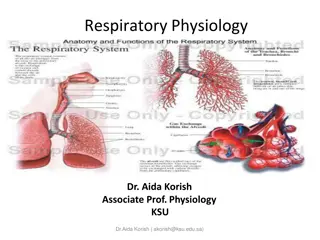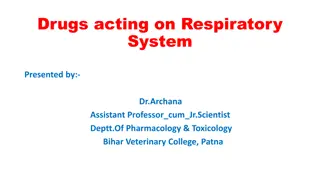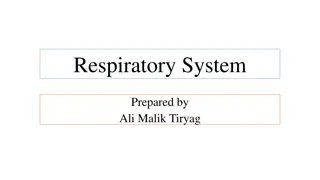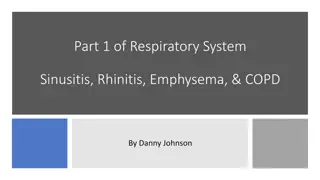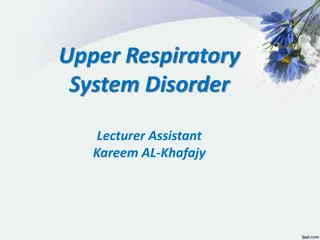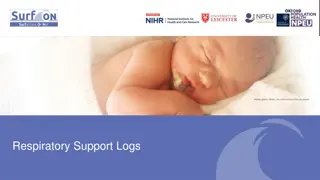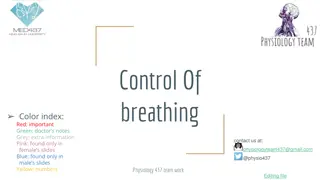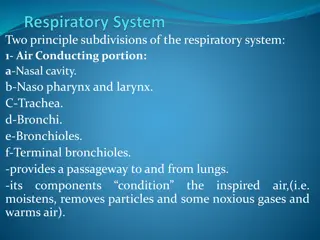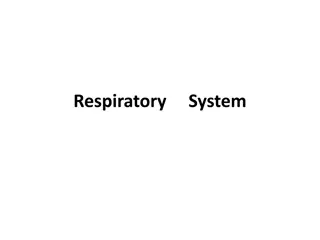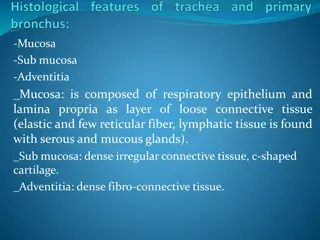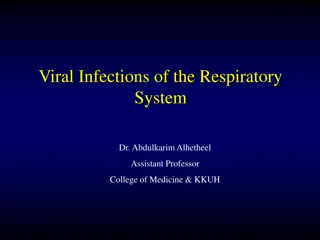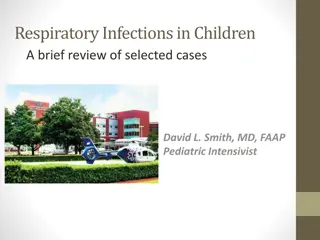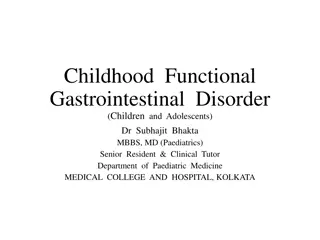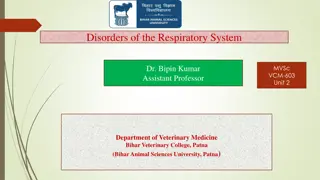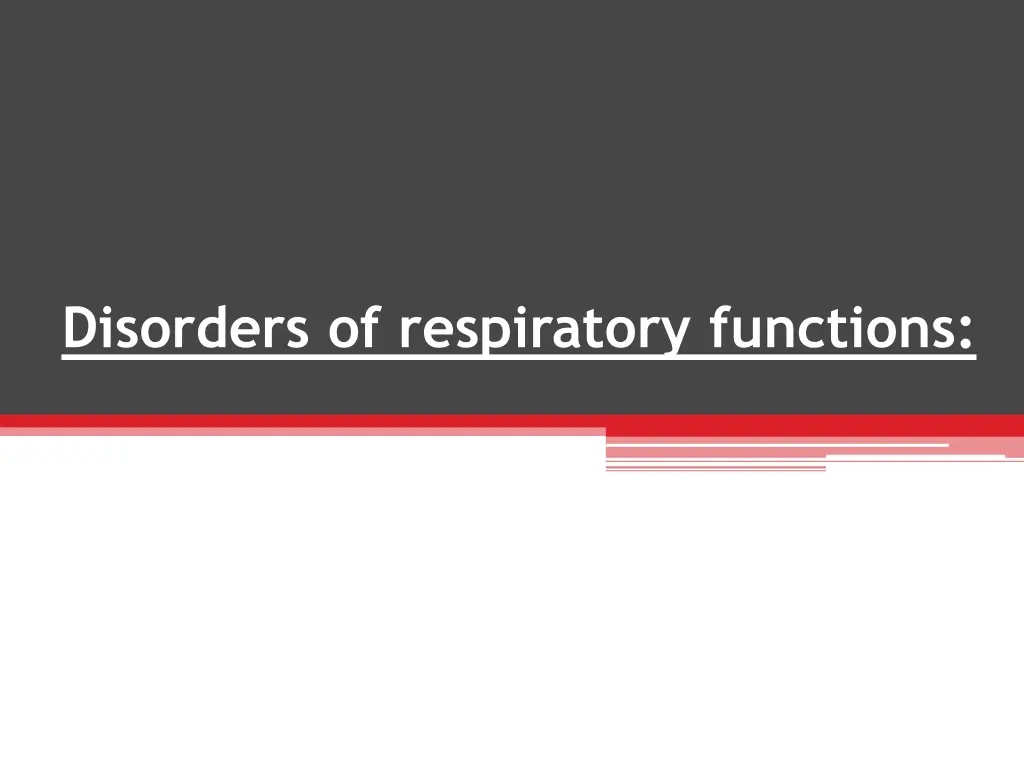
Understanding Pneumonias and Respiratory Disorders
Learn about the classification, causes, and symptoms of pneumonias, particularly focusing on acute bacterial (typical) pneumonias and pneumococcal pneumonia caused by Streptococcus pneumoniae. Discover the different types of pneumonias and how they can be acquired in the community or hospital setting. Understanding these respiratory disorders is crucial for early detection and proper treatment.
Download Presentation

Please find below an Image/Link to download the presentation.
The content on the website is provided AS IS for your information and personal use only. It may not be sold, licensed, or shared on other websites without obtaining consent from the author. If you encounter any issues during the download, it is possible that the publisher has removed the file from their server.
You are allowed to download the files provided on this website for personal or commercial use, subject to the condition that they are used lawfully. All files are the property of their respective owners.
The content on the website is provided AS IS for your information and personal use only. It may not be sold, licensed, or shared on other websites without obtaining consent from the author.
E N D
Presentation Transcript
Pneumonias: The term pneumonia describes inflammation of the parenchymal structures of the lung, such as the alveoli and bronchioles. It is a leading cause of death worldwide.
Classification: Pneumonias can be classifies according to the type of agent causing the infection into typical or atypical. Typical pneumonias results from infection by bacteria while atypical pneumonias are caused by viral and mycoplasma infections. Also, pneumonias can be classified according to distribution of infection into lobar and broncho pneumonias. The lobar pneumonias refers to involvement of a part or all of a lung lobe. While the broncho pneumonias signifies a patchy involvement of more than one lobe. Also, pneumonias community acquired pneumonias. The community acquired pneumonias refers to the organism found in community rather than hospital. can be classified as or hospital acquired
Acute bacterial (typical) pneumonias: The lung is normally sterile despite frequent entry of microorganisms into the air passages by inhalation. These organisms do not normally cause infection because of the small number that are aspirated and because the respiratory tract defense mechanisms prevent them from entering the distal air passages. Loss of the cough reflex , damage to the ciliated endothelium or impaired predispose to colonization of the lower respiratory system. Other risk factors include antibiotic therapy that alters the normal bacterial flora, diabetes, smoking, chronic bronchitis and viral infection. immune defenses
Pneumococcal pneumoniais: Streptococcus pneumoniae (pneumococcus) causes pyogenic (pus forming) infections primarily of the lungs, ears, sinuses and meninges. It is the most common cause of bacterial pneumoniae is an aerobic, diplococcus. The virulence of S. pneumoniae is a function of its polysaccharide prevents or delay digestion by phagocytes. The polysaccharides is an antigen that primarily elicits a B- cell response with antibody production. In the absence of antibodies, clearance relies on the reticuloendothelial system with macrophages in the spleen playing a major role. pneumonias gram . S. positive capsule, which
The pneumococcal infection is the attachment and colonization of the organism to the mucous and cells of nasopharynx . Colonization does not elicit signs of infection. Healthy people can be colonized and carry the organism without evidence of infection. The signs and symptoms pneumonias are; malaise, severe shaking chills and fever (above 41C ). during the initial step coughing brings up watery sputum, as the disease progresses, the character of sputum changes to bloody. Pleuritic pain is common. initial step in the pathogenesis of of pneumococcal
Legionnaires disease: Is a form of bronchopneumonia caused by gram- negative rod Legionella pneumophilia . The infection occurs when water that contains the pathogen is aerosolized and inhaled. Legionella pneumonia may present with malaise, lethargy, fever and dry cough. The presence of pneumonia with diarrhea, hyponatremia and confusion is characterstic of Legionella pneumonia. Another characteristics is lack of the normal pulse- temperature relationship in which fever is not accompanied by an appropriate rise in heart rate.
Primary Atypical pneumonia: Are characterized by a patchy involvement of the lung, largely confined to the alveolar, seputum and pulmonary interstitium. The term atypical denotes a lack of lung consolidation, production of moderate amount of sputum, moderate elevation of WBC and lack of alveolar exudate. These pneumonias are caused by a variety of agents; the most common being mycoplasma pneumoniae, othar etiologic agents include viruses adenovirus, rhinoviruses, measles and chickenbox viruses and chlamydia pneumoniae. The symptoms remain confined to fever , headache and muscle aches with a dry cough. (e.g influenza virus,
Tuberculosis: Etiology: Tuberculosis is an airborne infection caused by the M. tuberculosis mycobacteria are slender, aerobic that do not form spores. It has a waxy cell wall responsible for many of the bacteria characteristics including antigenicity, resistance disinfectants , antibiotics and laboratory stains. mycobacterium. rod-shaped The and its slow growth, detergents, to
Once stained; the dye cannot be discolored with acid solution ,hence; the name acid fast bacillus. T.B is an airborne infection spread by droplets of respiratory secretions by coughing, sneezing and talking. When the droplets evaporate; it leaves the organism suspended and circulated by air. Thus, living in crowded and confined conditions increase the risk of spread.
Pathogenesis: Macrophages are the primary cells infected with M. tuberculosis, inhaled droplets bronchial tree and deposited in the alveoli. Soon after entering the phagocytosed by alveolar macrophages , but resist destruction. Although, macrophages do not kill the microorganism, they initiate immune response. As T.B bacillius multiply; the infected macrophages degrade them and present their antigens to helper T- lymphocytes .The helper T- cells, in turn, stimulate macrophages to increase concentration of lytic enzymes to kill the bacillus. pass down the lungs, bacillus are a cell- mediated
In immunocompetent persons , the cell mediated immune response result in the development of a gray- white granulomatous lesion, called a Ghon focus, that contains the tubercle bacillius, modified macrophages and other immune cells. When the number of organisms is high, the Ghon focus undergoes necrosis, producing a soft, white core of dead cells referred to as a caseous (cheese- like) necrosis. Then, the T.B bacillius drains along the lymph channels to the tracheobronchial lymph nodes of the lung and they evoke the formation of caseous granuloma. The combination of the primary lung lesion and lymph node granulomas is called a Ghon complex. Ghon complex undergoes shrinkage, fibrous scarring and calcification to be visible radiographically.
Primary tuberculosis: It develops as a result of inhaling a droplet that contain T.B. bacillius. asymptomatic and go on to develop latent T.B infection in which macrophages surround granulomas that limits its spread. Individuals in latent T.B do not have active disease and cannot transmit the disease. The onset of symptoms is abrupt with high fever, pleuritis and lymph adenitis. Most people are T lymphocytes the organism and in
Secondary tuberculosis: It represents either reinfection from inhaled droplet or reactivation of a previously healed primary lesion. It occurs in cases of impaired body defense mechanism. After development of infection becomes quiescent formed as a result of immune response. These cavities are of (10-15) cm in diameter. hypersensitivity, . the are cavities
Clinical symptoms such as pleuritic pain due to extension of infection to pleural surfaces are common as the disease progresses. Signs and symptoms: low grade fever, night sweating, fatigue, anorexia and weight loss. A dry cough later becomes dyspnea and orthopnea are common. productive ,also
Respiratory distress syndrome (RDS): Also known as a hyaline membrane disease in premature infants; in which pulmonary immaturity with surfactant deficiency leads to alveolar collapse. Many infants are born with poorly functioning Type II alveolar cells (cells that produce surfactant) amount of surfactant. The incidence is high among male infants, white infants, infants of diabetic mothers, infants subjected to asphyxia, cold, stress and delivery by caesarian synthesis is influenced by insulin and cortisol. Insulin tends to inhibit surfactant production that s why infants of insulin- dependent diabetic mothers are at increased risk. section. Surfactant
Cortisol accelerates maturation of type II alveolar cells and formation of surfactant. In caesarian section: infants are not subjected to the stress of vaginal delivery which is thought to increase cortisol level. These observations have led to administration of corticosteroid drug to mothers before delivery of infants with a higher risk of RDS. Surfactant decreases surface tension in alveoli and decreases the amount of pressure needed to inflate the alveoli. Without surfactant; the large alveoli remain inflated, whereas the small alveoli become difficult to inflate.
At birth; the first breath requires high inspiratory pressure to expand the lungs. With a surfactant deficiency, the lungs collapse between breaths. A hyaline membrane forms inside the alveoli as protein- and fibrin- rich fluids are pulled into the alveolar space. The fibrin- hyaline membrane constitutes a barrier to gas exchange leading to hypoxemia and CO2 retention. Signs and symptoms: usually appear within the first 24 hrs. of birth including breathing, grunting sounds accompanying expiration, increase respiratory rate (60-120 breath/min) and fatigue. central cyanosis, difficult


